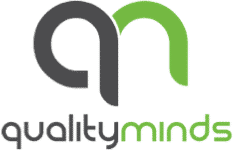A conversation with Katja, Team Lead Testing at QualityMinds
Katja’s working model is hybrid, meaning that she works from home 2-3 days a week and can be found in the office on the remaining days. In the following blog post, you can find out why she now really appreciates this combination, i.e. both remote work and working in the office, but why it wasn’t always like this.
Why does the hybrid working model work for you? What do you like about it?
Katja: The hybrid model works great for me because it allows me to interact with colleagues in the office in person while working undisturbed and productively from home.
One one hand, I really appreciate the personal contact with my colleagues during my days in the office. On the one hand, the physical proximity and personal contact means I can quickly get help or new ideas for my problems. Furthermore, I really enjoy the informal, interpersonal exchanges. In addition, there is always a lot of laughter in our office. That’s simply good between all the appointments.
On the other hand, two focused working days in the home office allow me to concentrate on tasks and focus for longer periods of time. Sometimes it also helps me to switch off notifications or set my Slack status to ‘Flow’ so that I’m not pulled out of a concentration phase.
Not having to commute to work is another advantage, as I can use the time I gain for personal matters such as sport, doctor’s appointments or household chores. Above all, I can fit in doctor’s appointments much more easily working from home than if I had to go to the office every day. Overall, this gives me the feeling that I can better balance my private and professional life and also have more time for myself.
I particularly appreciate the opportunity to spend more time with my family thanks to remote working. My family lives in the Rhineland, so visiting them from Munich is very time-consuming. However, remote work allows me to use the train journeys to work and spend a few days working away from my parents. That way, I can extend the short weekend visit a bit by packing in some work and still have more time with my family.
What are the challenges of working from home?
Katja: Despite the advantages of working from home, there were also some challenges for me at the beginning.
For example, the clear separation between work and private life was very important for me at the beginning, as I had experienced in my previous job that work often crept into my private life. That’s why I used to go to the office every day. With the start of the pandemic, however, I was forced to come to terms with working from home. I had to learn to switch off after work, close my laptop with a clear conscience and draw a clear line here. I manage to do this by taking a short walk, reading for a quarter of an hour or doing sport, for example. Today, I can no longer imagine doing without my home office days.
In my role as Team Lead, however, I naturally have to find ways to communicate well with my team. But there is no ‘one size fits all’ solution. Some of my team members love their remote work, others find it more difficult. Some work completely remotely, many hybrid, a few from the office every day. My job is to adapt to the different needs and accommodate everyone equally. This applies to both professional and personal issues. It’s important to me that there’s still time for a non-work-related chat during remote meetings that you would have had in the office at the coffee machine or over lunch.
Leading a team partially remotely works differently than when all team members are in the same office. You have to get involved and find out what the individual team members need. I communicate with my team via Teams for fixed appointments and via Slack for spontaneous matters. However, I try to avoid unannounced huddles (calls in the Slack communication tool) so as not to take my colleagues out of their flow or unintentionally put pressure on them to take the call.
It’s important to me to keep to my own working hours even when working from home and not always be available. It’s easy to feel under pressure to be constantly available. I have learned to consciously avoid this and to stop replying to work-related messages after work.
Conclusion
Katja: The hybrid working model offers me many advantages, including the freedom to work where I want and therefore the opportunity to spend more time with my family. Overall, the hybrid model has not only significantly improved the way I work, but also my quality of life and work-life balance.
My biggest challenge is to draw the line between my private life and my job and still ensure that my team can reach me at all times. Although my work desk is at home, I try to switch it off after work, not take my work with me and leave my work laptop switched off.
Would you like to find out more about the flexible working models at QualityMinds? Read the interviews with our colleagues Tobias and Richard.


0 Comments